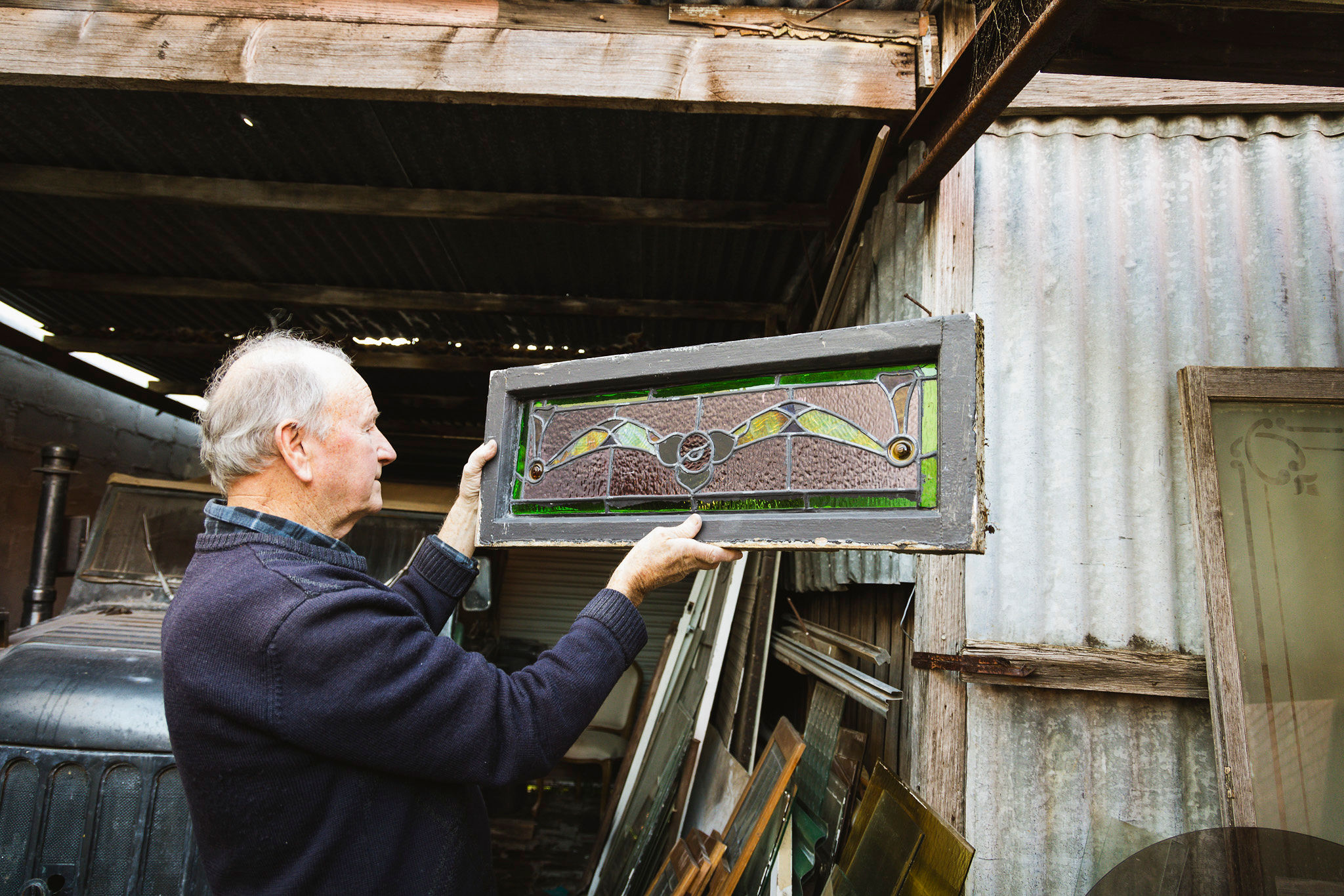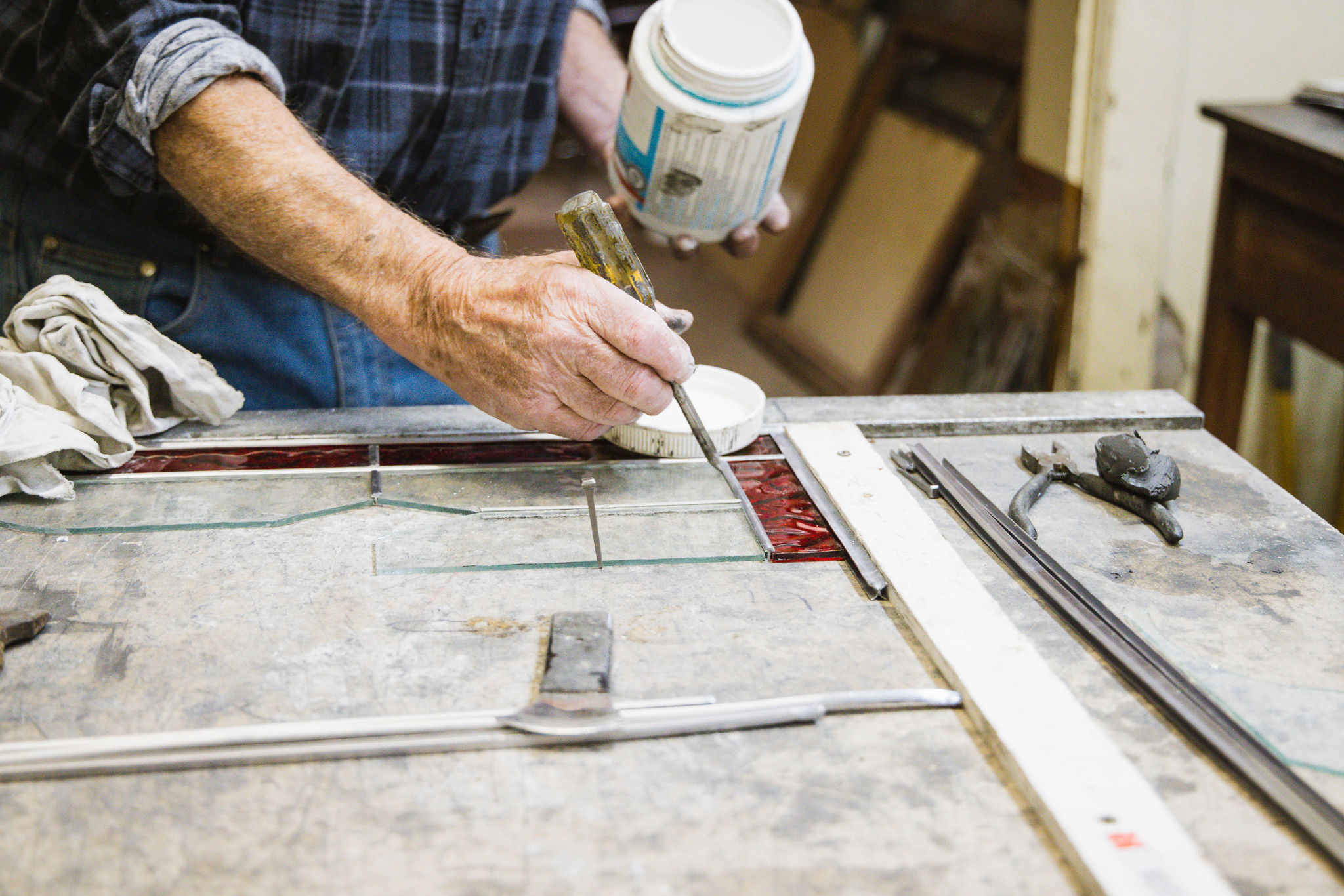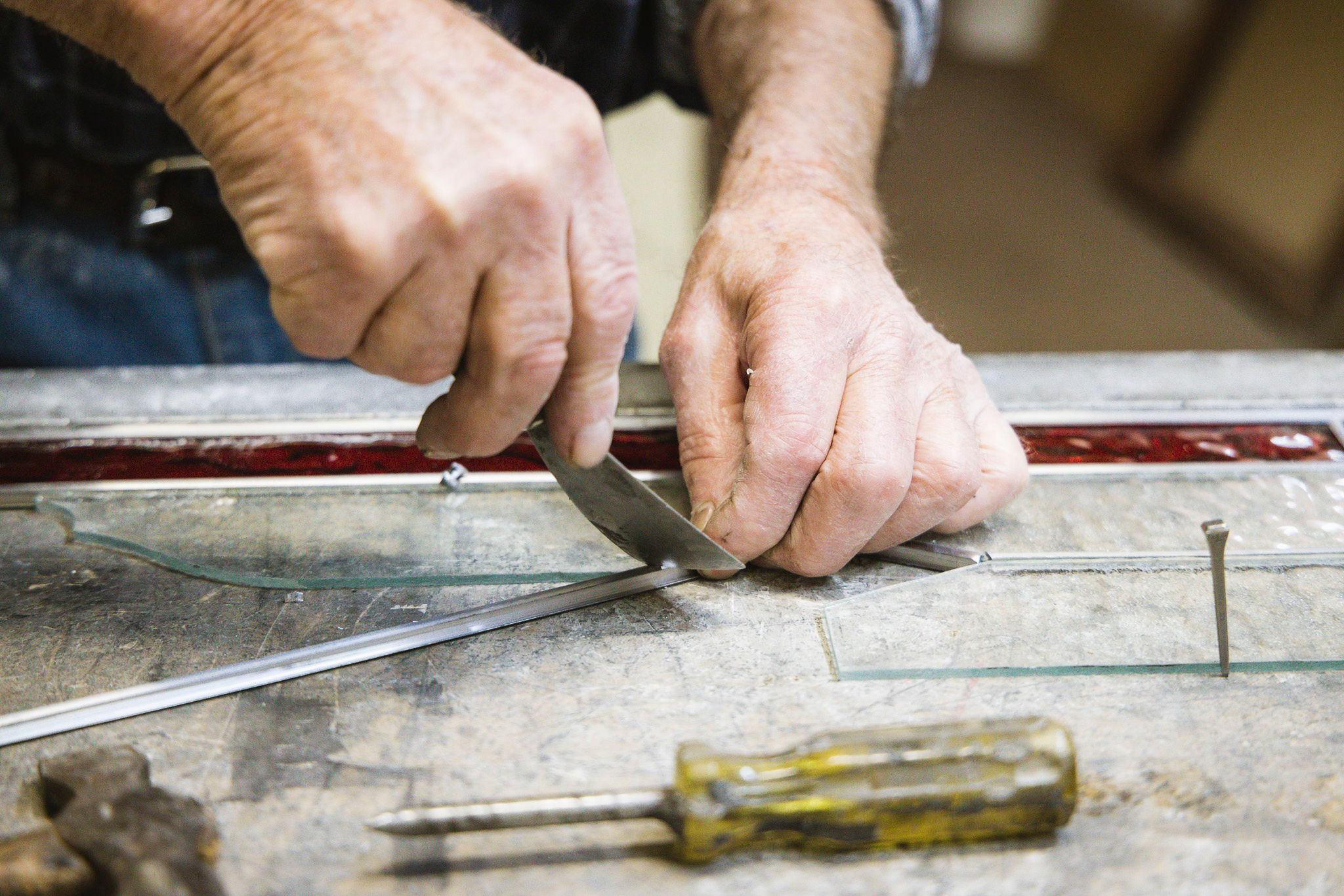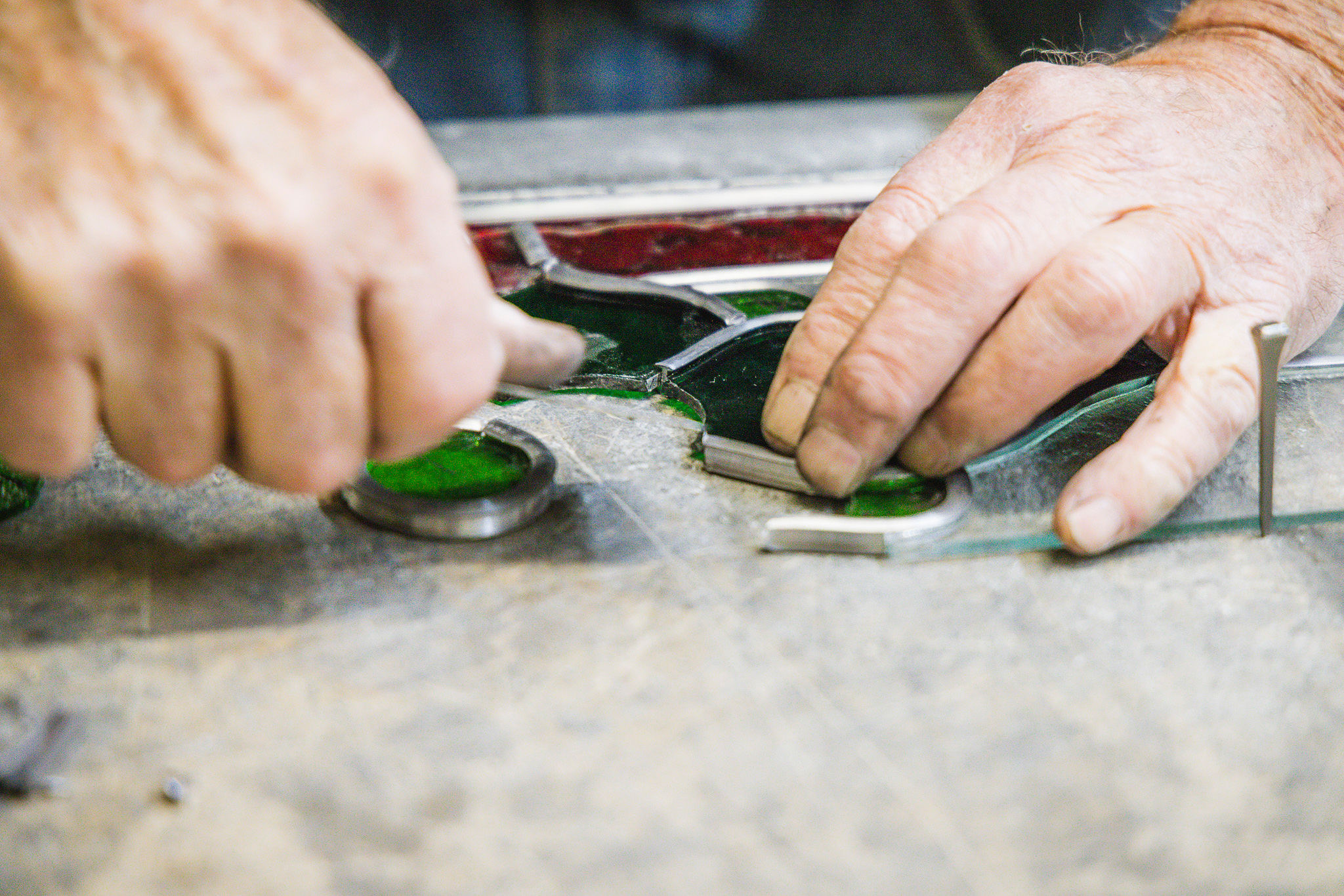Take a peek behind the scenes of some of Glen Eira’s long-running businesses. Get to know the owners and their stories and learn how Glen Eira’s streetscapes have changed over time in our digital exhibition Talking Shops: Glen Eira Stories.
Old Melbourne Leadlight
est. 1984
Address: 183 McKinnon Road, McKinnon
From an interview with Frank in 2021 by by Aron Lewin and Tatiana CC Scott from Tales of Brick and Mortar. Interview edited by Aron Lewin. All Photographs © Tatiana CC Scott. Developed for Glen Eira City Council for the Talking Shops project.




I was born in Blackpool, England.
In 1955, I left school at 15. The front door opened and my parents said, “Go find a job.”
My parents saw an ad in the paper which said, “Leadlighter, apprentice.” So, I applied. They gave me a job because I had a good school report, and was already doing something fiddly - I used to make model airplanes out of balsa wood, with wooden propellers.
The leadlight place where I worked was a shop which employed about ten people. I was cutting glass and tabletops from the beginning, and they trained me up. I remember turning up for the job, and old Jack was the foreman. The first thing I did was hang my coat on his hook. That was my first mistake. When they gave me the broom, and a container of water, I set to work splashing the water. It was supposed to go on the dust, not on the walls where the leadlights were. That was my next mistake.
I learned a lot there.
The apprenticeship finished, and we all walked in-part because leadlighting wasn’t popular anymore. I remember the men were only getting about 10 pounds a week, and everyone in the production line – from the glaziers to the glass-cutters and leadlight makers – gradually left.
In 1959 I got a job as a glass cutter and glazier, and worked until around 1966, when I came to Australia and found a job in the flat-glass industry.
I always wanted to travel and leave where I lived.
It was a bit of a struggle at times. Sometimes we'd run out of fuel in winter, and we’d climb over the railway and go down to the tracks to pick up coal. It was hard-going with six children in the house.
I came to Australia as a Ten-pound Pom, and came on The Fairstar at 26 years old. For 10 pounds, I had a four-week cruise. How about that? When I came to Melbourne, I worked for three companies. I went out to Melton, Keysborough, Springvale and North Dandenong, and worked on what were new estates at the time.
Somebody there knew about me being a leadlighter in the past, and also found out that Alan Sumner – a prominent artist and stained glass designer – was looking for someone to help with the cutting, assembly, the installation of the windows and so on. I picked up leadlighting again, and worked for him from 1970-1980.
I worked three nights a week and all-day Saturday, as well as working full time as a glazier.
It was hard, physical work.
When I was working with Alan Sumner, we’d install panels in major halls, churches, public buildings and so on.
We worked on Kostka Hall, Marillac House, Saint Paul’s Catholic Church in Bentleigh, The Glen Eira Town Hall Auditorium and so on.
Sumner did a lot of work for Catholics. Usually what happened was somebody in the family would die, and they'd want a memorial window in the church with an inscription plate at the bottom. We would remove the old, cheap crisscross leadlights, and put in a lovely memorial window.
He had a big kiln and a light-board, because his work would go in windows where light comes through. Alan would design a miniature of the window on a card, with everything on it. Then, it would go to a church committee if it was a religious work. Once approved, he would do everything – the designing and the painting – while I would cut the glass and make the windows.
Some of the windows he designed were absolutely stunning.
His work is all over Melbourne, and in the country.
Meanwhile, I was making leadlight windows from home.
After about five years, somebody came to the glazing shop where I was working.
He said, “Frank, why don't you become a contractor? Work for yourself and charge a bit more.” I started in the early 70s, and worked while living in Springvale. I had a bench in the garage at home, and was making small windows.
I then moved to McKinnon in 1983-1984. I left Moorabbin Glass – where I was working at the time – and rented a former hairdressers shop at 187 McKinnon Rd. I also did a bit of glazing because – when working on a leadlight – customers might say, “I've got a broken window.”
“Can you please fix it?”
Gradually, my business developed to the point where I had a few jobs at any given time. I was largely doing repairs, restoration and the odd job for the window frame manufacturer.
Word spread, and my name built up over 37 years.





This is how I do repairs.
If it's just a few pieces of broken glass within the structure of the leadlight, I take a photograph of it and make sure I write down the glass that’s broken. I measure the size, remove the broken piece and cut the new piece. I can do it on site if is not too badly damaged.
If it’s broken all over and the leadlights are really wobbly, it needs rebuilding. I’ll pull it apart, clean it all up, and re-lead it. Then I have to re-grout it. Leadlights are largely mass produced. The builders would go to a domestic leadlight shop and say, “We want number 9, 11, 13, 15 or 17.” But some people want something different, so you have to become familiar with different designs to be able to work the glass.
It’s a creative process to learn the designs, and fix them in a way that’s consistent with the original design. If I recreate a window or door, I'll usually take a photo and a rubbing. I put the rubbing on the whiteboard, get the blank piece of paper where you can see the rubbing underneath, then re-draw it.
I draw half of it. Then I turn it over, and redraw the other end.
You can get it nicely done.
I learned how to do the easy part of lead-lighting when I was an apprentice.
I also learned a lot with Alan Sumner over those years. Going into churches, pulling out the old leadlights and putting in the new ones. I’ve also worked on a lot of the streets around here. You have a house that's got nice leadlights on the ground floor and blank windows in the new extension. I would make what’s on the ground floor and put it up there.
The fashion has changed over the years, but the houses dictate what kind of leadlights the owners want. For example, with Victorian houses, there’s a lot of narrow, simple borders with a painted bird in the middle. Now that the style of housing has changed, they aren’t really doing that style anymore.
I’ll only do that type of work if it’s a restoration.
There’s all these different types of glass, and one is different to the other.
I can’t throw anything out. I’ll go outside, and find the right piece of glass that I need for a repair. I keep old glass as well, which has character. You can get the same color fading from very, very faint to very deep in all colours.
The nature of the job is picking the right bit of glass to use for a particular door or window, then putting it all together so it fits the design, and décor of the room.
Each day is different because each job is different.
My daughter Sarah worked with me in the late 1980s before moving to Cairns.
After she left, it was just me. I do everything myself.I bought this place in 1995, when it was cheap. I’ve been in this building for over 25 years, and in the same street for almost 37 years.
I’ve worked with glass from 15, to 82 now. It's a long time doing this work, but I still like it. Back in the day, I was working in churches, big halls and other public spaces. Now, it’s simpler – residential jobs. I still look forward to creating. I make a lot of flowers and birds: kookaburras, eagles and magpies.
They all start out with a drawing. A very simple drawing. It's just lead and glass that’s on the back of the door.
It's just me doing this creative, detailed work.
A lot of my customers have been coming for years.
If they like the work on a window, they might come back for the front door, then the bathroom and other parts of the house. Around here, I’m pretty well known, and a lot of it is word of mouth.
With COVID-19, I had a permit to work. If glass was broken, I was happy enough to fix it.
I work five days a week and on Saturdays I come in to the workshop before leaving at 12pm, and completing household jobs. People will ring with broken leadlight windows, and send me a picture of the damage. I’ll then assess what kind of glass I need and, if I can, I’ll repair it on site.
It’s something positive to do.
When I go into people’s houses, I can usually identify my work – even after a number of years.
People say that my work is artisanal, but men like Alan Sumner are the real artists.
My parents saw this ad when I was 15, and – without thinking about it too much – it set the course of my life. But, really, you have to find something to do.
Luckily, I found a profession that suited me.
I can do my own thing, and I intend to work for as long as I can.

